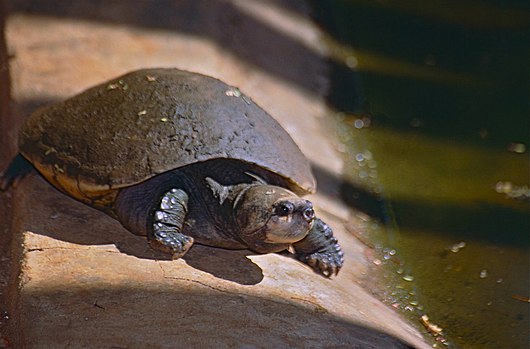Template:Especies-2018-09
Endangered species of the month
editMadagascan Big-headed Side-necked Turtle
editSome facts about this species:
Length: Adult straight-line carapace length of this turtle is most often circa 35 cm, but can reach 50 cm or more.
Weight: The body mass of adult specimen average from circa 4.90 kg (females) to 5.10 kg (males).
Habitat: Inhabits large, freshwater areas such as permanent slow moving rivers, backwaters and lakes. Hatchlings and juveniles often move into smaller bodies of water, such as slow moving streams or even rice paddy-fields, where they grow quickly before returning to larger bodies of water to mature and breed.
Distribution: The species is endemic to the western lowland river basins of Madagascar (up to an altitude of about 500 metres above sea level), from the Mangoky River in the south to the Sambirano region in the North.
Diet: Hatchlings and juveniles are predominantly carnivorous. Adult specimens are mainly herbivorous eating leaves, flowers and fruit, but occasionally also feed on small vertebrates.
Reproduction: Female turtles first produce eggs when they reach 25 to 30 cm carapace length but do not attain full reproductive potential until they are at least 32 cm in length. These turtles nest between September and January, though predominantly in October–December. Up to three clutches are laid each year. The average clutch size is 13 eggs, but large females can produce up to 20 eggs per clutch, i.e. 60 eggs in one year. The offspring's sex ratio in various populations varies from 1:2 to 1.7:1. Madagascan hatching- and breeding programmes are in place since 1999, however slow in progress. In 2004 a first batch of 158 turtles hatched from incubated eggs collected in the wild were released into Lake Ankomakoma. In 2015 a batch of 114 turtles successfully bred in captivity were released into Lake Ravelobe. That is the first time ever that captive bred Erymnochelys madagascariensis have been released into the wild.
Major threats: The species is exploited for food by the increasing human population of Madagascar. The minimum catch size is less than the size at sexual maturity, which is likely to lead to serious over-exploitation. Also, the habitat is fragmented by agricultural and deforestation practices, and siltation is a problem because of the conversion of lakes to rice fields.
Surviving number: The best available information in 2001 generated an estimate of some 10,000 animals making up some 20 subpopulations. Individual popuations comprise tens to a few hundred animals, the sole biggest being Lake Ambondrobe with approximately 5,000 specimens (2015).
Conservation status: Listed as Endangered by the IUCN in 1996. Listed as Critically Endangered since 2008 (IUCN 3.1), with populations in decline. The Madagascan big-headed turtle is considered one of the most endangered reptiles in the world, and is also included in the Turtle Conservation Funds (TFC) top 25 endangered turtles list.
First described: Grandidier, A. 1867. Liste des reptiles nouveaux découverts, en 1866, sur la côte sud-ouest de Madagascar. Revue et magasin de zoologie pure et appliquée (2)19: 232–234.
